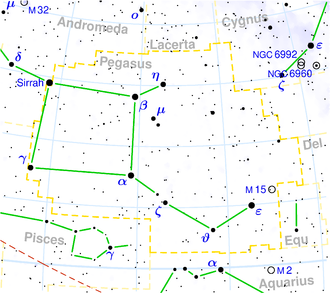NGC 7760
| Galaxie NGC 7760 | |
|---|---|
![NGC 7760[1] SDSS-Aufnahme](http://upload.wikimedia.org/wikipedia/commons/thumb/9/9e/NGC7760_-_SDSS_DR14.jpg/300px-NGC7760_-_SDSS_DR14.jpg) | |
| NGC 7760[1] SDSS-Aufnahme | |
| AladinLite | |
| Sternbild | Pegasus |
| Position Äquinoktium: J2000.0, Epoche: J2000.0 | |
| Rektaszension | 23h 49m 11,94s[2] |
| Deklination | +30° 58′ 59,3″[2] |
| Erscheinungsbild | |
| Morphologischer Typ | E?[2][3] |
| Helligkeit (visuell) | 13,6 mag[3] |
| Helligkeit (B-Band) | 14,6 mag[3] |
| Winkelausdehnung | 0,9' × 0,9'[3] |
| Flächenhelligkeit | 13,4 mag/arcmin²[3] |
| Physikalische Daten | |
| Zugehörigkeit | isoliert[2] |
| Rotverschiebung | 0.017505 ± 0.000033[2] |
| Radialgeschwindigkeit | 5248 ± 10 km/s[2] |
| Hubbledistanz vrad / H0 | (243 ± 17) · 106 Lj (74,4 ± 5,2) Mpc [2] |
| Geschichte | |
| Entdeckung | William Herschel |
| Entdeckungsdatum | 9. Oktober 1790 |
| Katalogbezeichnungen | |
| NGC 7760 • UGC 12794 • PGC 72512 • CGCG 498-014 • MCG +05-56-008 • 2MASX J23491191+3058590 • GC 5015 • H III 854 • h 2271 • LDCE 1597 NED004 • WISEA J234911.94+305859.5 • KIG 1042 | |
NGC 7760 ist eine Galaxie vom Hubble-Typ E? im Sternbild Pegasus am Nordsternhimmel. Sie ist schätzungsweise 243 Millionen Lichtjahre von der Milchstraße entfernt und hat einen Durchmesser von etwa 65.000 Lichtjahren.
Im selben Himmelsareal befindet sich die Galaxie NGC 7773.
Das Objekt wurde am 9. Oktober 1790 von Wilhelm Herschel entdeckt.[4]
Weblinks
Einzelnachweise
Auf dieser Seite verwendete Medien
Autor/Urheber: Sloan Digital Sky Survey, Lizenz: CC BY 4.0
The sky image is obtained by Sloan Digital Sky Survey, DR14 with SciServer.
Angle of view: 4' × 4' (0.3" per pixel), north is up.
Details on the image processing pipeline: https://www.sdss.org/dr14/imaging/jpg-images-on-skyserver/



